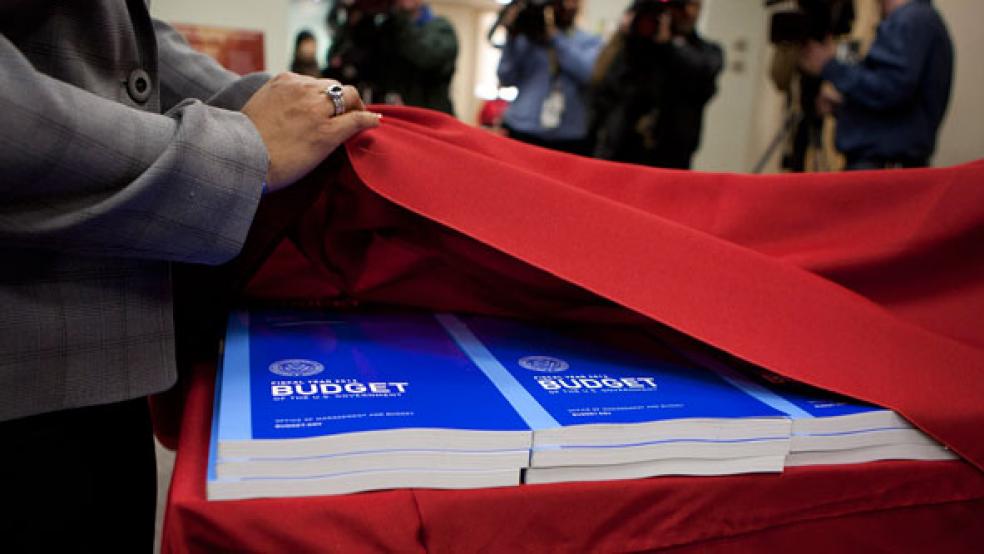You don’t have to read too heavily into President Obama’s 2013 budget proposal to grasp his bottom line: America needs to ramp up investments in education, green energy, and housing – and the nation’s highest earning individuals and businesses should pay for it.
It’s a familiar refrain from Obama, who this year reprises many of the same tax-the-rich principles from last year’s budget blueprint in order to raise a projected $1.5 trillion in new revenue over the next decade. On the business side, repeat performances include calls to rid the tax code of the more than $41 billion in tax breaks for oil and gas companies and to subject the slice of profits investment fund managers take home to ordinary income tax rates instead of the 15 percent capital gains rate they currently pay.
RELATED: Obama's 'Campaign' Budget: The Winners and Losers
Most of this year’s revenue-producing proposals are aimed squarely at America’s most affluent individual taxpayers, which the White House defines as individuals earning more than $200,000 a year or couples making more than $250,000. With the exception of a new provision to tax dividends as ordinary income, all of the document’s proposals to tax wealthy individuals more were part of last year’s budget and were swiftly knocked down by House and Senate Republicans, who continue their unflappable opposition to any kind of tax hike. “So much like in 2012, this likely won’t actually mean much change for the wealthy folks,” says Martin Sullivan, a contributing editor at Tax Analysts and former Treasury official. But it could earn Obama some major points on the campaign trail, which likely was his goal all along, Sullivan says.
Here’s a breakdown of the most striking tax changes for top earners included in Obama’s 2013 budget.
1. Ending the Bush-Era Tax Cuts
The tax cuts signed into law by President George W. Bush are set to expire at the end of the year. Obama would extend them for the middle class, but allow them to end for those making more than $200,000 a year or couples making more than $250,000. The top rate would return to 39.6 percent, from its current 35 percent. Republicans want to keep the tax cuts for top earners too, setting up a battle that we’ve seen before. The last time, in 2010, Obama agreed to extend all the Bush-era tax cuts for two years, setting up this potential second showdown.
2. A Higher Rate on Dividend Income…
The new budget plan would raise $206.4 billion over a decade by taxing dividends as ordinary income for high earners. In past budgets, Obama has called to increase dividend income tax rates from the current 15 percent to 20 percent. But under his 2013 budget, the wealthiest taxpayers and businesses, who now pay a 15 percent tax rate on dividend income, would see their dividend rates rise to as high as 39.6 percent if the Bush-era tax cuts expire, or 43.4 percent including another new tax on unearned income that could affect a small group of taxpayers (see No 7 below).
3. …and on Capital Gains, Too
In his 2013 budget proposal, Obama again seeks to hike the tax rate on long-term capital gains – meaning profits from investments and real estate – from 15 percent to 20 percent, a change that he also called for last year. While this change would affect all investors, those in the middle-class tend to hold their stocks and bonds in tax-sheltered retirement accounts like IRAs and 401(k)s, meaning the effects of such a hike would fall largely on the wealthy who derive a greater share of their income from their investment holdings. Over the past 20 years, about half of all capital gains have gone to the wealthiest 0.1 percent of taxpayers, like Mr. Buffett or presidential hopeful Mitt Romney, according to an analysis by Forbes. More than 80 percent has gone to the top 5 percent of earners.
4. The Buffett Rule
As promised in his State of the Union address last month, Obama would create an alternative minimum tax of 30 percent to levy on anyone earning more than $1 million a year. The president dubbed the change "The Buffett Rule" after billionaire investor Warren Buffett, who wrote a scathing editorial in The New York Times criticizing the U.S. tax system for “coddling” investment moguls, allowing them to pay a smaller share of their income in federal taxes than middle-class taxpayers. It would be meant as a total replacement for the current Alternative Minimum Tax. Although the White House mentions the Buffett Rule in its 2013 budget, it doesn’t detail exactly how it would structure this new tax, and doesn’t provide estimates on how much it would add to federal coffers. But a Fiscal Times analysis of Internal Revenue Service data from earlier this month found that the Buffett Rule could bring the federal government at least an additional $30 billion in revenue.
5. Estate Tax Redux
If a loved one passes away this year, the car, home, or other assets they leave behind would be taxed at lower rates than they would be in 2013 under Obama’s proposal. The current estate tax rate is 35 percent, with an exemption of $5.12 million in assets — a level that Obama and Congressional Republicans agreed on in December 2010 as part of a deal to extend the Bush-era tax cuts until the end of 2012. But whereas many Congressional Republicans would like to eliminate the estate tax altogether, Obama suggests it as a revenue-raiser in his 2013 budget, and bumps the tax rate up to 45 percent and knocks the exemption down to $3.5 million. That change alone would bring the Treasury $968 billion in revenue over 10 years.
If a loved one passes away this year, the car, home, or other assets they leave behind would be taxed at lower rates than they would be in 2013 under Obama’s proposal. The current is 35 percent, with an exemption of $5.12 million in assets — a level that Obama and Congressional Republicans agreed on in December 2010 as part of a deal to extend the Bush-era tax cuts until the end of 2012. But whereas many Congressional Republicans would like to eliminate the estate tax altogether, Obama suggests it as a revenue-raiser in his 2013 budget, and bumps the tax rate up to 45 percent and knocks the exemption down to $3.5 million. That change alone would bring the Treasury $968 billion in revenue over 10 years.
6. Cutting Deductions
The president’s budget proposal includes a change that the charitable and housing industries feared: a limit on how much donating to charity or taking out a home mortgage can shave off an itemizers’ tax bill. State and local governments might also be burned, since the cap also applies to high-earners who deduct the interest they pay on municipal bonds. A major reason why investors take on state and local debt is to reap the generous interest exemption they can log on their taxes from it. State and local governments fear the limit might lead high-earners to invest elsewhere.
High-income taxpayers in the top two income brackets can deduct 33 or 35 percent of qualified expenses at years’ end. But Obama proposes capping that amount at 28 percent for any filer who earns more than $200,000 (or $250,000 for a couple). This change would slash the federal deficit by $584 billion over a decade, the White House said. It’s hard to predict how much the cap could reduce charitable giving, homeownership, and the popularity of munis, but advocates for those interests say the proposed change could rock state and local governments as well as the charitable and housing sectors.
7. A Tax on Unearned Income
The health-care reform law the president signed back in 2010 included a Medicare tax of 3.8 percent on investment income for high earners. That tax is set to kick in next year, and would be levied on income derived from investments, including capital gains, dividends, rental properties and the sale of real estate – but only for a very small number of taxpayers, and only on gains exceeding some pretty high thresholds. For sales of primary homes, the tax would only apply to any gains above $250,000 for an individual or $500,000 for a married couple. “In its first year of application, 2013, the new Medicare tax will hit approximately the top-earning two percent of families,” the Tax Foundation noted in a 2010 report.





